Tribological Behavior of Titanium Alloy Treated by Nitriding and Surface Texturing Composite Technology
Abstract
:1. Introduction
2. Experimental Details
2.1. Materials
2.2. Plasma Nitriding Treatment
2.3. Laser Surface Texturing Treatment
2.4. Characterizations
2.5. Friction and Wear Test
3. Results and Discussion
3.1. Surface Morphologies
3.2. Structural Characteristics of the Nitrided Samples
3.3. Frictional Properties
3.4. The Wear Mechanism
4. Conclusions
- The microhardness of the titanium alloy was significantly improved after nitriding. With the increase of nitriding temperature, the nitride content of the nitriding layer on the surface of the titanium alloy increases and the surface hardness also increases. However, at the same time, the brittleness and roughness of the nitride layer also increase.
- Due to the increase of hardness, brittleness, and roughness of nitriding layer, the friction coefficient of nitrided titanium alloy increases first and then decreases with the increase of nitriding temperature. The wear volume tends to decrease first and then increase with the increase of nitriding temperature.
- After the surface texture treatment, the friction coefficient of nitrided titanium alloy samples decreases in varying degrees. When the nitriding temperature is lower (750~850 °C), the wear volume after the combined treatment is larger than that after the nitriding treatment. When the nitriding temperature is higher (900~950 °C), the wear volume of samples after the combined treatment is less than that of the nitrided sample. This indicates that when the nitriding temperature is higher, the surface texture can play a role in improving the wear resistance of the nitrided titanium alloy.
- The wear mechanism of the titanium alloy sample after nitriding is mainly the adhesive wear and the abrasive wear. The adhesive wear dominates when the nitriding temperature is low, while abrasive wear dominates when the nitriding temperature is high. The wear mechanism of the titanium alloy sample after nitriding/texture combined treatment is mainly adhesive wear. The surface textures prepared on the surface of the nitrided titanium alloy with high hardness show the ability of storing wear debris. Therefore, it can effectively increase the wear resistance of the titanium alloy.
Author Contributions
Funding
Conflicts of Interest
References
- De Formanoir, C.; Martin, G.; Prima, F.; Allain, S.Y.; Dessolier, T.; Sun, F.; Vivès, S.; Hary, B.; Brechet, Y.; Godet, S. Micromechanical behavior and thermal stability of a dual-phase alpha plus alpha’ titanium alloy produced by additive manufacturing. Acta Mater. 2019, 162, 149–162. [Google Scholar] [CrossRef]
- De Formanoir, C.; Martin, G.; Prima, F.; Allain, S.Y.; Dessolier, T.; Sun, F.; Vivès, S.; Hary, B.; Brechet, Y.; Godet, S. Evaluation of mechanical and wear properties of Ti–xNb–7Fe alloys designed for biomedical applications. Mater. Des. 2016, 111, 592–599. [Google Scholar] [CrossRef]
- Dong, H.; Bell, T. Enhanced wear resistance of titanium surfaces by a new thermal oxidation treatment. Wear 2000, 238, 131–137. [Google Scholar] [CrossRef]
- Pohrelyuk, I.M.; Sheykin, S.E.; Padgurskas, J.; Lavrys, S.M. Wear resistance of two-phase titanium alloy after deformation-diffusion treatment. Tribol. Int. 2018, 127, 404–411. [Google Scholar] [CrossRef]
- Cassar, G.; Banfield, S.; Wilson, J.A.; Housden, J.; Matthews, A.; Leyland, A. Micro-abrasion wear testing of triode plasma diffusion and duplex treated Ti–6Al–4V alloy. Wear 2012, 274, 377–387. [Google Scholar] [CrossRef] [Green Version]
- Farokhzadeh, K.; Qian, J.; Edrisy, A. Effect of SPD surface layer on plasma nitriding of Ti–6Al–4V alloy. Mater. Sci. Eng. A 2014, 589, 199–208. [Google Scholar] [CrossRef]
- Li, Z.; Cai, Z.; Wu, Y.; Zhu, M. Effect of nitrogen ion implantation dose on torsional fretting wear behavior of titanium and its alloy. Trans. Nonferr. Met. Soc. China 2017, 27, 324–335. [Google Scholar] [CrossRef]
- Liu, Y.-C.; Lin, G.S.; Wang, J.-Y.; Cheng, C.-S.; Yang, Y.-C.; Lee, B.-S.; Tung, K.-L. Synthesis and characterization of porous hydroxyapatite coatings deposited on titanium by flame spraying. Surf. Coat. Technol. 2018, 349, 357–363. [Google Scholar] [CrossRef]
- Koshuro, V.; Fomin, A.; Rodionov, I. Composition, structure and mechanical properties of metal oxide coatings produced on titanium using plasma spraying and modified by micro-arc oxidation. Ceram. Int. 2018, 44, 12593–12599. [Google Scholar] [CrossRef]
- Costa, M.Y.; Venditti, M.L.; Voorwald, H.J.; Cioffi, M.O.; Cruz, T.G. Effect of WC–10%Co–4%Cr coating on the Ti–6Al–4V alloy fatigue strength. Mater. Sci. Eng. A 2009, 507, 29–36. [Google Scholar] [CrossRef]
- Amanov, A.; Cho, I.S.; Kim, D.E.; Pyun, Y.S. Fretting wear and friction reduction of CP titanium and Ti–6Al–4V alloy by ultrasonic nanocrystalline surface modification. Surf. Coat. Technol. 2012, 207, 135–142. [Google Scholar] [CrossRef]
- Ye, Y.; Kure-Chu, S.Z.; Sun, Z.; Li, X.; Wang, H.; Tang, G. Nanocrystallization and enhanced surface mechanical properties of commercial pure titanium by electropulsing-assisted ultrasonic surface rolling. Mater. Des. 2018, 149, 214–227. [Google Scholar] [CrossRef]
- Kamat, A.M.; Copley, S.M.; Todd, J.A. A two-step laser-sustained plasma nitriding process for deep-case hardening of commercially pure titanium. Surf. Coat. Technol. 2017, 313, 82–95. [Google Scholar] [CrossRef]
- Ahmed, S.; Chakrabarty, D.; Bhowmik, S.; Mukherjee, S.; Rane, R. Plasma nitriding on titanium surface for adhesion promotion. Surf. Eng. 2015, 31, 616–622. [Google Scholar] [CrossRef]
- Hu, T.; Hu, L.; Ding, Q. The effect of laser surface texturing on the tribological behavior of Ti–6Al–4V. Proc. Inst. Mech. Eng. Part J J. Eng. Tribol. 2012, 226, 854–863. [Google Scholar] [CrossRef]
- Lin, N.; Li, D.; Zou, J.; Xie, R.; Wang, Z.; Tang, B. Surface Texture-Based Surface Treatments on Ti6Al4V Titanium Alloys for Tribological and Biological Applications: A Mini Review. Materials 2018, 11, 487. [Google Scholar] [CrossRef] [PubMed]
- Zhang, B.; Dong, Q.; Ba, Z.; Wang, Z.; Shi, H.; Xue, Y. Tribological properties of surface-textured and plasma-nitrided pure titanium under oil lubrication condition. J. Mater. Eng. Perform. 2018, 27, 186–193. [Google Scholar] [CrossRef]
- Zhang, B.; Dong, Q.; Ba, Z.; Wang, Z.; Shi, H.; Xue, Y. Laser melting of plasma nitrided Ti–6Al–4V alloy. Wear 1997, 212, 140–149. [Google Scholar] [CrossRef]
- Pfleging, W.; Kumari, R.; Besser, H.; Scharnweber, T.; Majumdar, J.D. Laser surface textured titanium alloy (Ti–6Al–4V): Part 1—Surface characterization. Appl. Surf. Sci. 2015, 355, 104–111. [Google Scholar] [CrossRef]
- Yilmazer, H.; Yilmaz, S.; Acma, M.E. Treatment of surface properties of titanium with plasma (ion) nitriding. Defect Diffus. Forum 2009, 283–286, 401–405. [Google Scholar] [CrossRef]
- Bansal, D.G.; Eryilmaz, O.L.; Blau, P.J. Surface engineering to improve the durability and lubricity of Ti–6Al–4V alloy. Wear 2011, 271, 2006–2015. [Google Scholar] [CrossRef]
- Hosseini, S.R.; Ahmadi, A. Evaluation of the effects of plasma nitriding temperature and time on the characterization of Ti6Al4V alloy. Vacuum 2013, 87, 30–39. [Google Scholar] [CrossRef]
- Oliveira, S.D.; Tschiptschin, A.P.; Pinedo, C.E. Simultaneous plasma nitriding and ageing treatments of precipitation hardenable plastic mould steel. Mater. Des. 2007, 28, 1714–1718. [Google Scholar] [CrossRef]
- Rahman, M.; Reid, I.; Duggan, P.; Dowling, D.P.; Hughes, G.; Hashmi, M.S. Structural and tribological properties of the plasma nitrided Ti-alloy biomaterials: Influence of the treatment temperature. Surf. Coat. Technol. 2007, 201, 4865–4872. [Google Scholar] [CrossRef]
- Molinari, A.; Straffelini, G.; Tesi, B.; Bacci, T.; Pradelli, G. Effects of load and sliding speed on the tribological behaviour of Ti-6Al-4V plasma nitrided at different temperatures. Wear 1997, 203, 447–454. [Google Scholar] [CrossRef]
- She, D.; Yue, W.; Fu, Z.; Wang, C.; Yang, X.; Liu, J. Effects of nitriding temperature on microstructures and vacuum tribological properties of plasma-nitrided titanium. Surf. Coat. Technol. 2015, 264, 32–40. [Google Scholar] [CrossRef]
- Ali, M.M.; Raman, S.G.; Pathak, S.D.; Gnanamoorthy, R. Influence of plasma nitriding on fretting wear behaviour of Ti–6Al–4V. Tribol. Int. 2010, 43, 152–160. [Google Scholar] [CrossRef]
- Wahab, J.A.; Ghazali, M.J.; Yusoff, W.M.; Sajuri, Z. Enhancing material performance through laser surface texturing: A review. Trans. IMF 2016, 94, 193–198. [Google Scholar] [CrossRef]
- Qiu, M.F.; Minson, B.R.; Raeymaekers, B. The effect of texture shape on the friction coefficient and stiffness of gas-lubricated parallel slider bearings. Tribol. Int. 2013, 67, 278–288. [Google Scholar] [CrossRef]
- Ibatan, T.; Uddin, M.S.; Chowdhury, M.A.K. Recent development on surface texturing in enhancing tribological performance of bearing sliders. Surf. Coat. Technol. 2015, 272, 102–120. [Google Scholar] [CrossRef]
- Braun, D.; Greiner, C.; Schneider, J.; Gumbsch, P. Efficiency of laser surface texturing in the reduction of friction under mixed lubrication. Tribol. Int. 2014, 77, 142–147. [Google Scholar] [CrossRef]
- Yamakiri, H.; Sasaki, S.; Kurita, T.; Kasashima, N. Effects of laser surface texturing on friction behavior of silicon nitride under lubrication with water. Tribol. Int. 2011, 44, 579–584. [Google Scholar] [CrossRef]
- Morita, T.; Asakura, K.; Kagaya, C. Effect of combination treatment on wear resistance and strength of Ti–6Al–4V alloy. Mater. Sci. Eng. A 2014, 618, 438–446. [Google Scholar] [CrossRef]
- Borghi, A.; Gualtieri, E.; Marchetto, D.; Moretti, L.; Valeri, S. Tribological effects of surface texturing on nitriding steel for high-performance engine applications. Wear 2008, 265, 1046–1051. [Google Scholar] [CrossRef]
- Mullan, F.; Austin, R.S.; Parkinson, C.R.; Hasan, A.; Bartlett, D.W. Measurement of surface roughness changes of unpolished and polished enamel following erosion. PLoS ONE 2017, 12, e0182406. [Google Scholar] [CrossRef] [PubMed]
- Piao, Z.Y.; Xu, B.S.; Wang, H.D.; Wen, D.H. Influence of surface roughness on rolling contact fatigue behavior Fe–Cr alloy coatings. Mater. Eng. Perform. 2013, 22, 767–773. [Google Scholar] [CrossRef]
- Qiu, T.Q.; Tien, C.L. Short-pulse laser heating on metals. Int. J. Heat Mass Trans. 1992, 35, 719–726. [Google Scholar] [CrossRef]
- Brorson, S.D.; Kazeroonian, A.; Moodera, J.S.; Face, D.W.; Cheng, T.K.; Ippen, E.P.; Dresselhaus, M.S.; Dresselhaus, G. Femtosecond room-temperature measurement of the electron–phonon coupling constant γ in metallic superconductors. Phys. Rev. Lett. 1990, 64, 2172–2175. [Google Scholar] [CrossRef] [PubMed]
- Ahmmed, K.T.; Ling, E.J.; Servio, P.; Kietzig, A.M. Introducing a new optimization tool for femtosecond laser-induced surface texturing on titanium, stainless steel, aluminum and copper. Opt. Laser Eng. 2015, 66, 258–268. [Google Scholar] [CrossRef]
- Wang, M.; Wang, C.; Kang, J.; Zhu, L.; Yue, W.; Fu, Z. Effects of shape parameters of laser surface texture on tribological performance of titanium alloy. China Surf. Eng. 2017, 30, 71–77. [Google Scholar]
- Wang, Z.; Zhao, Q.; Wang, C.; Zhang, Y. Modulation of dry tribological property of stainless steel by femtosecond laser surface texturing. Appl. Phys. A 2015, 119, 1155–1163. [Google Scholar] [CrossRef]
- Xing, Y.; Deng, J.; Feng, X.; Yu, S. Effect of laser surface texturing on Si3N4/TiC ceramic sliding against steel under dry friction. Mater. Des. 2013, 52, 234–245. [Google Scholar] [CrossRef]

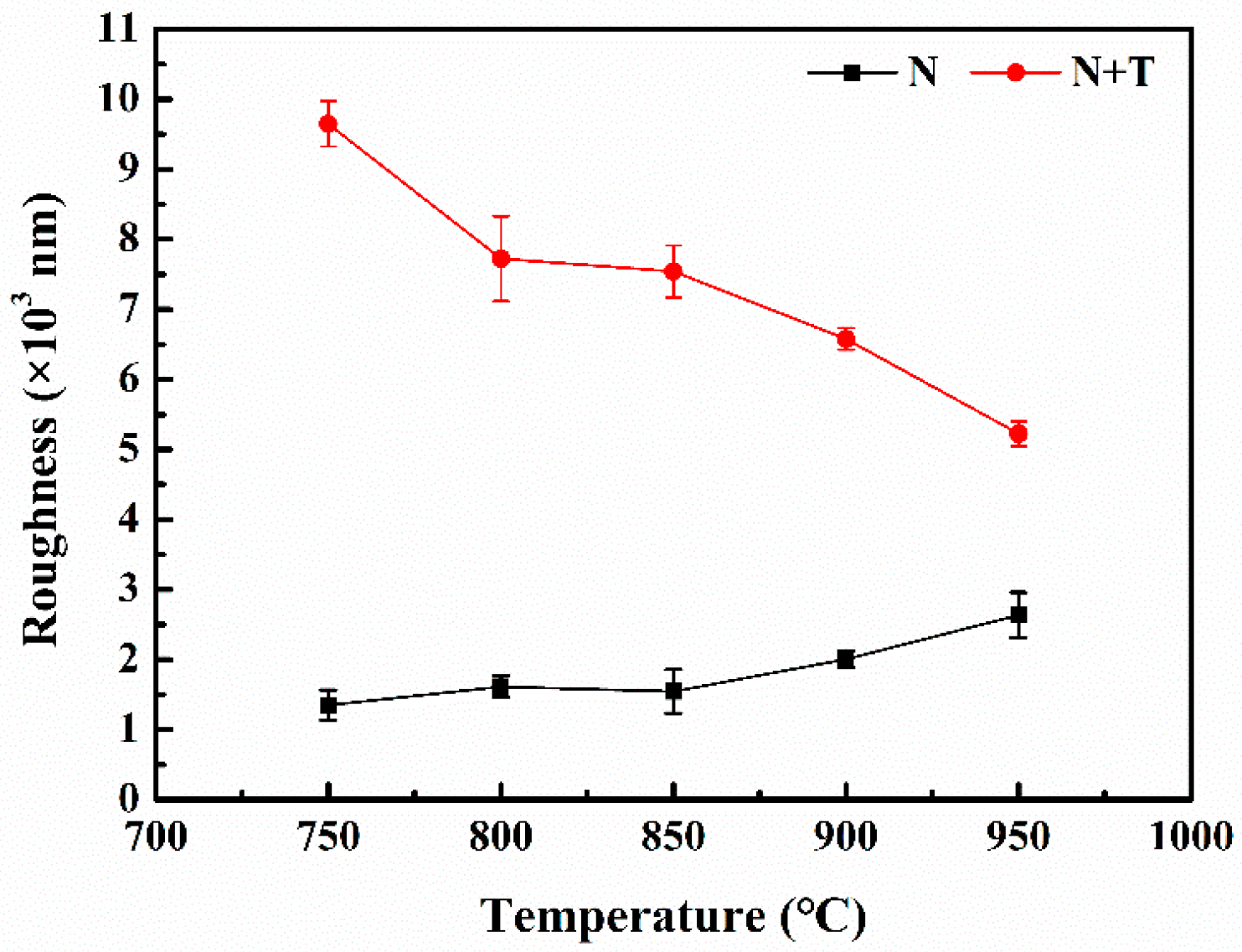

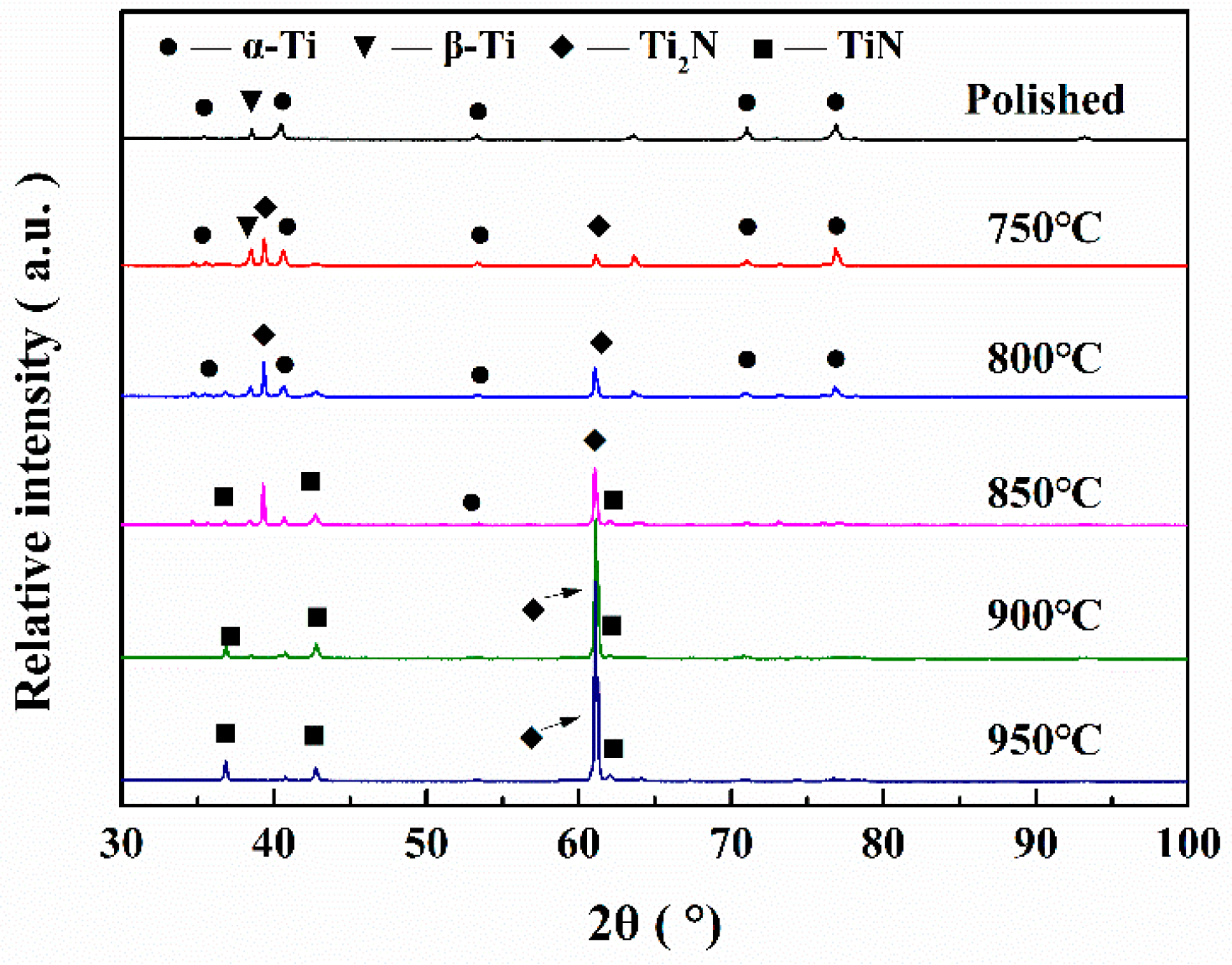

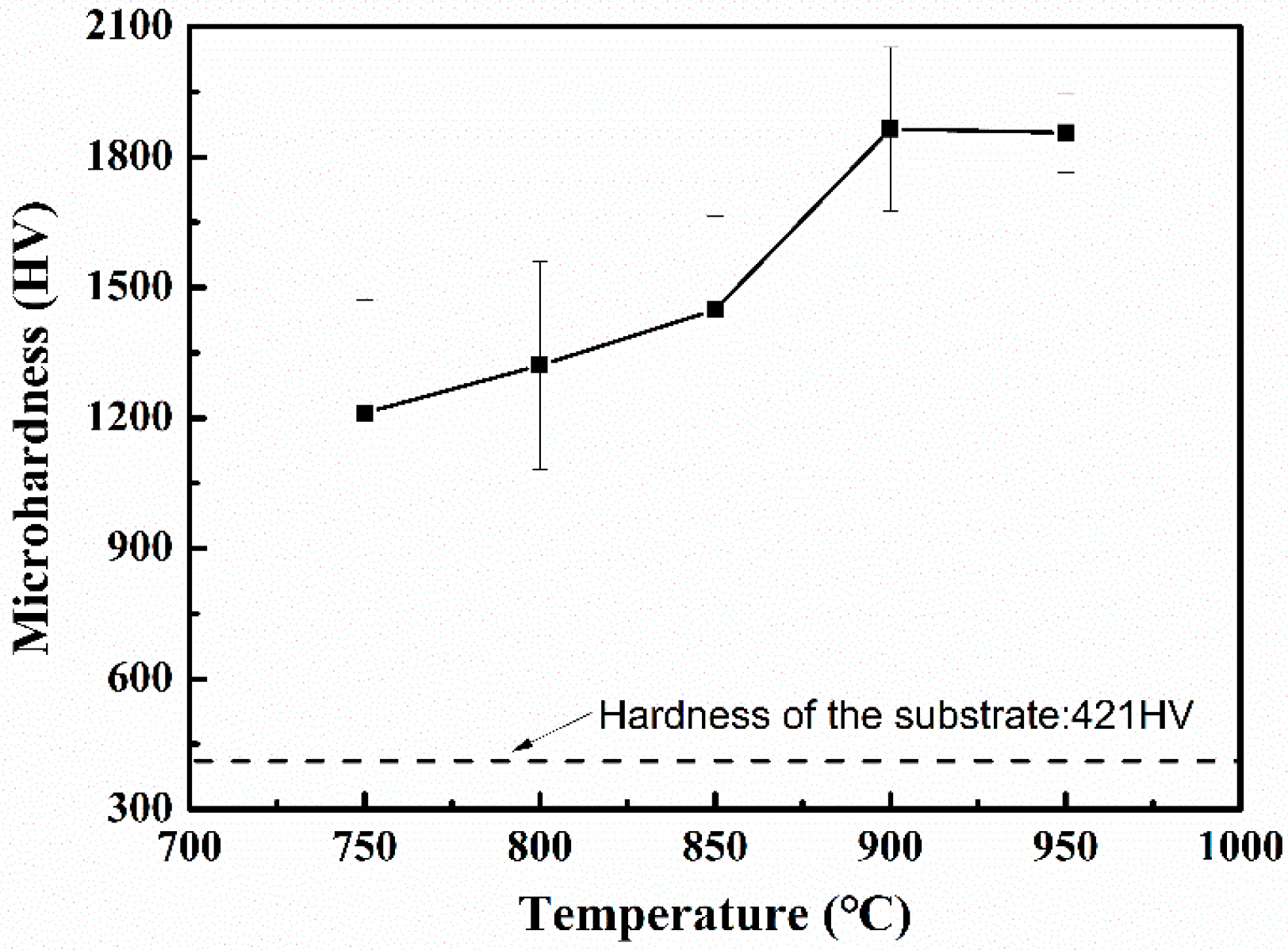
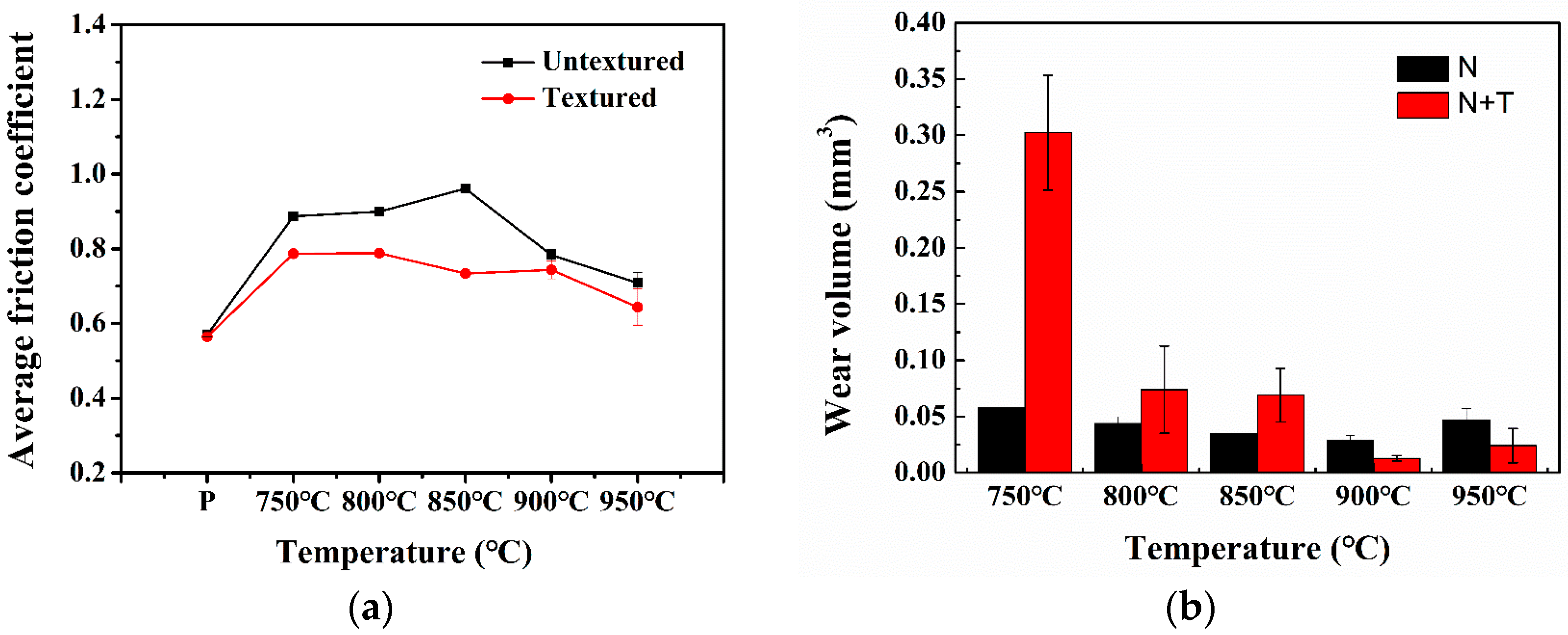
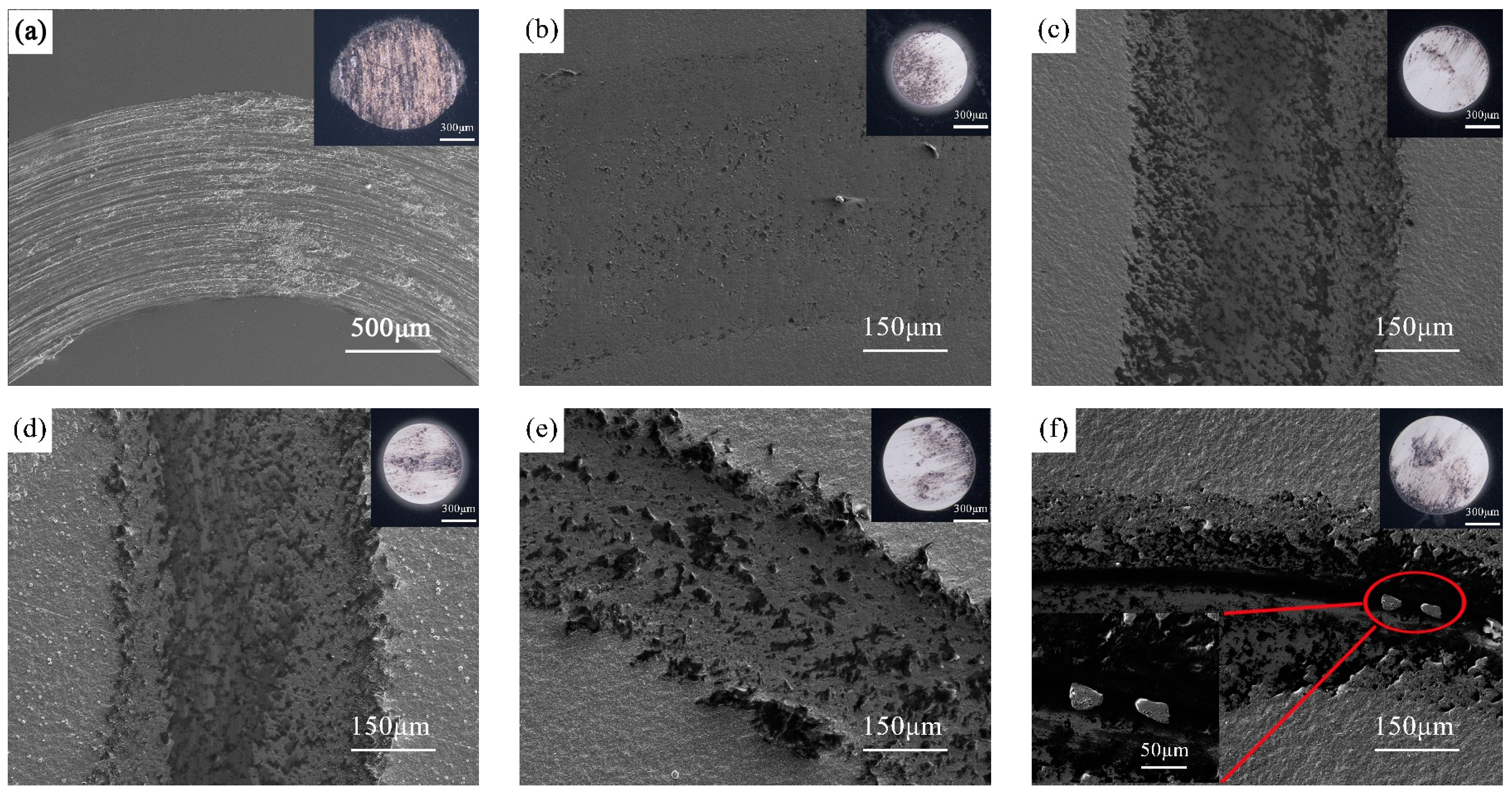
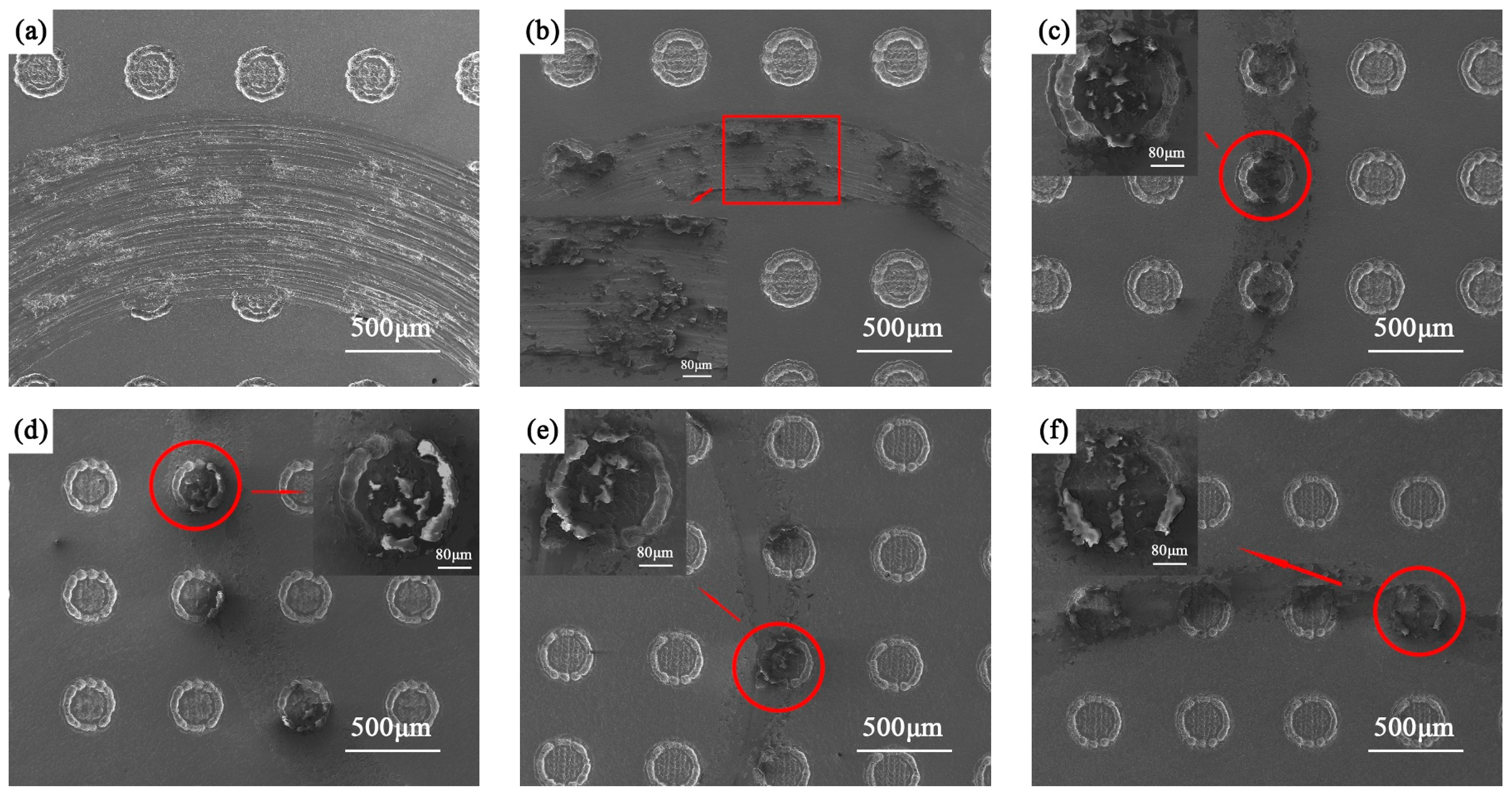
© 2019 by the authors. Licensee MDPI, Basel, Switzerland. This article is an open access article distributed under the terms and conditions of the Creative Commons Attribution (CC BY) license (http://creativecommons.org/licenses/by/4.0/).
Share and Cite
Kang, J.; Wang, M.; Yue, W.; Fu, Z.; Zhu, L.; She, D.; Wang, C. Tribological Behavior of Titanium Alloy Treated by Nitriding and Surface Texturing Composite Technology. Materials 2019, 12, 301. https://doi.org/10.3390/ma12020301
Kang J, Wang M, Yue W, Fu Z, Zhu L, She D, Wang C. Tribological Behavior of Titanium Alloy Treated by Nitriding and Surface Texturing Composite Technology. Materials. 2019; 12(2):301. https://doi.org/10.3390/ma12020301
Chicago/Turabian StyleKang, Jiajie, Mingzheng Wang, Wen Yue, Zhiqiang Fu, Lina Zhu, Dingshun She, and Chengbiao Wang. 2019. "Tribological Behavior of Titanium Alloy Treated by Nitriding and Surface Texturing Composite Technology" Materials 12, no. 2: 301. https://doi.org/10.3390/ma12020301




